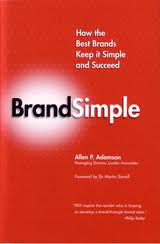BrandSimple: How the Best Brands Keep It Simple and Succeed

– By Allen P. Adamson
As marketers, we are exposed to so many theories and ideas that it can all get pretty confusing. Many marketing gurus – including Al Ries and Jack Trout – have been arguing that branding is not as complex and complicated as many experts make it out to be; actually it is all common sense.
In his book, Adamson aims to explain ‘why brands built on simple ideas are the most successful brands.’ He cautions that simple should not be confused with simplistic – it takes rigorous thinking, discipline and focus to get to a simple idea.
Adamson outlines simple guidelines for developing brands that have a good chance of succeeding in the real world. However, he states that before starting a brand or a branding project, one should ask the following questions (given to him by Stewart Owen, a person who helped develop the BrandAsset Valuator Tool (Young & Rubicam’s proprietary tool): \
- What’s the business strategy?
- What does the brand stand for in the minds of the customers (or prospective customers)?
- Can the business strategy be aligned with what the brand has to stand for? In other words, can a company deliver on the promise of the brand idea?
Many brands fail because there is a disconnect between the business strategy and the brand idea.
Adamson recommends a simple set of guidelines for developing successful brands:
- Establish your brand idea. This would mean establishing ‘a simple and meaningful point of difference for your brand that you’ll be able to embed in people’s minds.’
- Capture the essence of your brand. This entails coming out with a ‘single phrase or sentence that captures the core meaning of the brand idea.’ This could be called the brand driver (as Adamson’s company – Landor – does), the brand handle, the brand axis or the brand DNA. A good brand driver should not leave any scope for ambiguity or confusion; on the other hand, it provides long term focus and direction for your brand.
- Get your employees engaged in the idea. Communicating the brand idea and its essence internally is, according to Adamson, a critical step. This is because the entire organisation is involved in the development and selling of a product and everyone must understand what the brand stands for.
- Consider your brand name. Ideally, the brand name should be simple and meaningful enough to capture the brand’s idea.
- Create branding signals beyond the brand name. ‘Virtually any form of branding expression – packaging, advertising, web sites, signage, product design or functionality, vehicles, retail environments, even refrigerator magnets – can be a power signal.’
Adamson uses examples from brands like Apple, GE, FedEx, IBM, KFC and others to amplify his points.
BrandSimple is a straightforward book on branding and there is nothing here that an experienced marketer doesn’t already know. To that extent, it is more likely to be of use to beginners and to entrepreneurs who are not too well versed in branding. However, because it outlines some simple steps, experienced marketers may find that branding is, after all, a lot simpler than many of them make it to be.
Rating: B+
